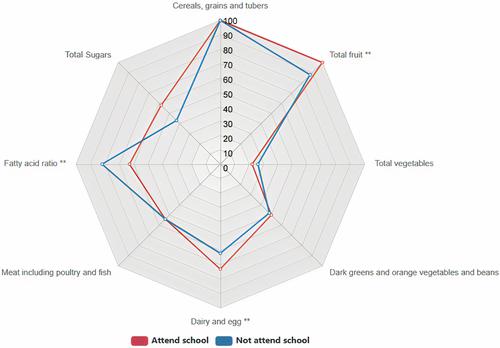当前位置:
X-MOL 学术
›
Ann. N. Y. Acad. Sci.
›
论文详情
Our official English website, www.x-mol.net, welcomes your feedback! (Note: you will need to create a separate account there.)
Diet quality, school attendance, and body weight status in adolescent girls in rural Guatemala
Annals of the New York Academy of Sciences ( IF 5.2 ) Pub Date : 2021-01-27 , DOI: 10.1111/nyas.14558 Violeta Chacón 1, 2 , Qinran Liu 3 , Yikyung Park 3 , Peter Rohloff 4 , Joaquin Barnoya 1, 5
Annals of the New York Academy of Sciences ( IF 5.2 ) Pub Date : 2021-01-27 , DOI: 10.1111/nyas.14558 Violeta Chacón 1, 2 , Qinran Liu 3 , Yikyung Park 3 , Peter Rohloff 4 , Joaquin Barnoya 1, 5
Affiliation

|
A cluster of factors affects nutritional status among adolescent girls in low- and middle-income countries (LMICs). We investigated the association between school attendance and diet quality among 498 rural adolescent girls (352 attending and 146 not attending school) in Tecpán, Guatemala. In a cross-sectional study, we collected sociodemographic and anthropometric data and characterized the dietary intake using a Food Frequency Questionnaire. We then calculated diet quality using the Healthy Eating Score (HES). Multiple linear regression models were conducted to evaluate the effects of school attendance on diet quality. We found that the overall diet quality among the study participants was poor, according to the HES. However, those who attended school had significantly higher intakes of vitamin A–rich fruits and vegetables (P = 0.04), other fruits (P = 0.01), and milk and milk products (P = 0.004), but a higher intake of fast foods, chips, and saturated fatty acids (P < 0.001). Furthermore, the effects of school attendance on diet quality were significant after adjusting for sociodemographic and lifestyle factors (β coefficient = −1.70, 95% CI: −3.30 to −0.11) but was attenuated when further adjusted for weight status (β coefficient = −1.58, 95% CI: −3.17 to 0.02). Our findings suggest that diet quality among girls in rural Guatemala is poor, particularly among those who do not attend school. To advance our understanding of adolescent diet in LMICs, future studies should include adolescents who are out of school.
中文翻译:

危地马拉农村少女的饮食质量、入学率和体重状况
一系列因素影响低收入和中等收入国家 (LMIC) 少女的营养状况。我们调查了危地马拉 Tecpán 的 498 名农村少女(352 名上学和 146 名未上学)的入学率与饮食质量之间的关系。在一项横断面研究中,我们收集了社会人口学和人体测量数据,并使用食物频率问卷来描述饮食摄入量。然后,我们使用健康饮食评分 (HES) 计算饮食质量。采用多元线性回归模型评估学校出勤率对饮食质量的影响。根据 HES,我们发现研究参与者的整体饮食质量很差。然而,那些上学的人摄入的富含维生素 A 的水果和蔬菜的摄入量明显更高(P = 0.04)、其他水果 ( P = 0.01) 和奶及奶制品 ( P = 0.004),但快餐、薯片和饱和脂肪酸的摄入量较高 ( P < 0.001)。此外,在调整社会人口和生活方式因素后,入学率对饮食质量的影响显着(β 系数 = -1.70, 95% CI:-3.30 至 -0.11),但在进一步调整体重状况后会减弱(β 系数 = - 1.58, 95% CI:-3.17 至 0.02)。我们的研究结果表明,危地马拉农村女孩的饮食质量很差,尤其是那些不上学的女孩。为了加深我们对中低收入国家青少年饮食的理解,未来的研究应该包括失学的青少年。
更新日期:2021-01-27
中文翻译:

危地马拉农村少女的饮食质量、入学率和体重状况
一系列因素影响低收入和中等收入国家 (LMIC) 少女的营养状况。我们调查了危地马拉 Tecpán 的 498 名农村少女(352 名上学和 146 名未上学)的入学率与饮食质量之间的关系。在一项横断面研究中,我们收集了社会人口学和人体测量数据,并使用食物频率问卷来描述饮食摄入量。然后,我们使用健康饮食评分 (HES) 计算饮食质量。采用多元线性回归模型评估学校出勤率对饮食质量的影响。根据 HES,我们发现研究参与者的整体饮食质量很差。然而,那些上学的人摄入的富含维生素 A 的水果和蔬菜的摄入量明显更高(P = 0.04)、其他水果 ( P = 0.01) 和奶及奶制品 ( P = 0.004),但快餐、薯片和饱和脂肪酸的摄入量较高 ( P < 0.001)。此外,在调整社会人口和生活方式因素后,入学率对饮食质量的影响显着(β 系数 = -1.70, 95% CI:-3.30 至 -0.11),但在进一步调整体重状况后会减弱(β 系数 = - 1.58, 95% CI:-3.17 至 0.02)。我们的研究结果表明,危地马拉农村女孩的饮食质量很差,尤其是那些不上学的女孩。为了加深我们对中低收入国家青少年饮食的理解,未来的研究应该包括失学的青少年。


























 京公网安备 11010802027423号
京公网安备 11010802027423号